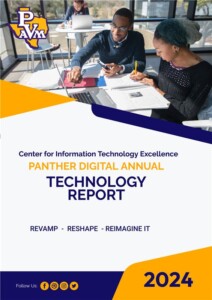
Message From The CIO

Dear University Community,
I am pleased to share with you the technology annual report for the year 2024, which showcases the accomplishments and innovations of the Information Technology (IT) department in supporting the mission and vision of our university. In the past year, we have made significant progress in enhancing our network infrastructure, wireless connectivity, enterprise resource planning (ERP) system, financial aid readiness, cyber awareness training, and cyberinfrastructure symposium. Here are some of the highlights:
- We upgraded our network backbone to 100 Gbps, which increased the speed and reliability of our data transmission and communication across the campus.
- We expanded our wireless coverage to 95% of the campus, including outdoor areas, and began implementing a new authentication system that will greatly improve the security and convenience of our wireless access.
- We enhanced our ERP system with new features and functionalities, such as automation, integration, and analytics, that streamlined our business processes and improved our operational efficiency and effectiveness.
- We completed the financial aid readiness project, which ensured that our financial aid system was compliant with the latest federal and state regulations and standards, and that our students received timely and accurate financial aid information and assistance.
- We hosted a series of cyber awareness training sessions for our students, faculty, and staff, which covered topics such as password management, phishing prevention, data protection, and online safety. We also launched a new cyber awareness website that provides resources and tips on how to stay safe and secure online.
- We organized a successful cyberinfrastructure symposium, which attracted over 100 participants from our university and other institutions, and featured keynote speakers, panel discussions, workshops, and poster presentations on the latest trends and developments in cyberinfrastructure and its applications in research and education.
These are just some of the examples of how we have leveraged technology to enhance our teaching, learning, research, and service activities. We are proud of our achievements, but we are also aware of the challenges and opportunities that lie ahead. We are committed to continuous improvement and innovation, and we look forward to collaborating with you to advance our university’s strategic goals and priorities.
Thank you for your support and feedback, and please feel free to contact me or any member of the IT department if you have any questions, comments, or suggestions.
Infrastructure Services

Introduction
The Infrastructure Services team provides support and solutions for the PVAMU infrastructure system, applications and services across the university. This document summarizes the major accomplishments and challenges of the Infrastructure Services team in the fiscal year 2023-2024. It also outlines the goals and priorities for the next fiscal year.
Accomplishments
Over the past year, the infrastructure team has completed several major projects and implementations that have improved the security, connectivity, stability, and effectiveness of the PVAMU infrastructure. These implementations will allow for a more reliable infrastructure with improved connectivity speed that is ready to meet the current and future demands of students, faculty, researchers, and staff. The wireless upgrade and expansion project The following is a list of the successful projects and implementations and impacts on the PVAMU environment:
Wireless upgrade project
- Increased the number of outdoor Access points to provide improved outdoor wireless coverage for students, faculty, and staff.
- Updated the Wireless controller to ensure continued security
- Replaced outdated and unsupported Access points within campus buildings to provide continued wireless service to faculty/staff/ students, improve wireless coverage, and increase data connectivity speeds for streaming
- Implemented Eduroam for the PVAMU campus environment to allow external visitors access to their university wifi connections from the PVAMU campus
Core infrastructure and switch upgrade project
- Physically restructured the PVAMU data center to improve the manageability of systems critical to the success of the university
- Added improved network redundancy and improved connectivity to over 60% of campus buildings. (Buildings were upgraded based on connectivity requirements of the users and/or grant requirements)
- Replaced 230 outdated and unsupported switches that presented a significant bottleneck to end users and a substantial security risk to the university as these devices were end-of-life and end-of-support from vendors
- Implemented new redundant core network routers with 100GB capability to future-proof PVAMU
- Implemented new firewalls to reduce the security risk and vulnerabilities presented by the previous firewalls, increasing the university’s security posture. The new firewalls will also allow the future expansion of connectivity speeds for the campus from 10 GB/s to 40 GB/s, increasing the campus bandwidth by more than four times the current speed.
- Implemented an external network to facilitate the operation of the checkout kiosk and to improve the video streaming of live events from the university
- Implement network monitoring to be more proactive in identifying possible network issues and latency
- Rewire multiple campus buildings to increase connectivity speeds to end-user endpoint devices and to prepare for the future needs of Faculty, staff, researchers and students.
Phone system upgrade and migration
- Procured and partially implemented new highly redundant cloud calling services (Ucaas)
- Migrated multiple users to the new cloud platform for phone services. The new platform allows PVAMU users to do so without having to be connected to the PVAMU network
- Upgraded the university’s call center call tree for enrollment management to provide improved customer support to students calling in.
Homedrive migration and University Services
- Migrated TAMUS SSO to using PVAMU single sign on to provide an improved process for accessing TAMUS resources (Workday, Concur)
- Migrated user home drives (H drives) to one drive to allow users to be able to access data from any location
- Resolved issues with the web service’s ability to be able to send emails from the website
- Implemented multiple projects that required Single Sign-on integration with the PVAMU system
- Implementation of the new payment system for Auxiliary Services
- Reviewed, researched, and advised multiple research faculty members on the infrastructure required for research initiatives and teaching
- Complete multiple open record request, password resets
- Partnered with the BAS team at TAMUS to build a VPN (virtual) tunnel between PVAMU and TAMUS to provide better access and monitoring of building automation systems.
Information Security

Introduction
The Information Security team is responsible for establishing and maintaining a university-wide information security management program to ensure that the university’s data and assets are adequately protected. This document summarizes the major accomplishments and challenges of the Information Security team in the fiscal year 2023-2024. It also outlines the goals and priorities for the next fiscal year.
Accomplishments
The Information Security team completed several technical implementations in support of the development and delivery of comprehensive information security controls to optimize the security posture of the university:
- Abnormal Security (Email Security):
- Comprehensive email security solution that complements Microsoft’s threat intelligence-based defenses with precise, behavioral AI-based security
- Fully automates email triage, remediation, and reporting, bringing together all auto-detected and user-reported threats into a single interface
- Assesses email content and self-learns user preferences as they move emails within their mailbox to automatically remediate unwanted mail; this personalized approach provides a native Microsoft experience that eliminates spam digests and portals
- Rapid7 (Vulnerability Management):
- Prioritizes vulnerabilities on a defined scale indicating those that are actively being exploited in the wild or the likelihood of an attacker exploiting the vulnerability in a real attack
- Assigns and tracks remediation duties in real-time, providing continuous visibility into how well issues are being fixed
- Ensures teams are making (and tracking) progress towards goals and service level agreements (SLAs) at an appropriate pace, and maintaining compliance with standards
- Forcepoint (Data Loss Prevention)
- Addresses the challenge of data security with zero friction to the user experience
- Replaces broad, sweeping rules with individualized, adaptive data security that doesn’t slow down employees
- Automatically block actions based on an individual user’s risk level with risk-adaptive data protection
- Arctic Wolf (Managed Detection and Response):
- 24X7 Monitoring Environment is monitored by a third party for threats and risk around the clock, allowing internal resources to focus on other important areas of the business
- Managed Investigations Suspicious activity is investigated by MDR service, making alert fatigue and time wasted on investigating false positives a thing of the past
- Root Cause Analysis Deep investigations into the root cause of incidents to promote the creation of customized rules and workflows that harden security posture
The Information Security team facilitates annual PCI DSS compliance attestation activities across the university, in coordination with TAMU Accounting Services. New payment processing equipment supporting point-to-point encryption (P2PE) is being procured. Such an investment can significantly reduce the PCI DSS validation effort of a merchant’s cardholder data environment. This solution cryptographically protects account data from the point where a merchant accepts the payment card to the secure point of decryption. By using P2PE, account data (cardholder data and sensitive authentication data) is unreadable until it reaches a secure decryption environment, which makes it less valuable if the data is stolen in a breach.
ERP Services

Introduction
The ERP Services team provides support and solutions for the Banner system and its integrations with various applications and services across the university. The team consists of seven staff members who work closely with the functional offices and vendors to ensure the smooth operation and enhancement of the ERP system. This document summarizes the major accomplishments and challenges of the ERP Services team in the fiscal year 2023-2024. It also outlines the goals and priorities for the next fiscal year.
Accomplishments
The ERP Services team completed several projects and implementations that improved the efficiency and effectiveness of the Banner system and its integrations. The following is a list of the successful projects and implementations by functional area:
- For Office of Registrar:
- Automate importing grades from Acadeum to Banner
- Digitalizing close to 20k hard copy student documents and getting them imported to BDM
- For office of Financial Aid:
- ERP Services has been supporting Financial Aid team in their efforts to set up 24-25 Aid year, filling in the gap of a critical staff member (Swaytha). Appreciation email from Dr. Willis mentioning that PV was the only BANNER school on the call that has awarded for fall 2024
- Campus Logic – Helping the Financial Aid Team set up the CL processes and integrating them with Banner
- For Office of Admissions:
- Automate Admissions Project: ERP Services team helped set up the automation of UG Admissions in TEST. (Being tested for production)
- SOATEST – Automate Calculation of scores in SOATEST
- Automate import of Parchment documents to BDMS
- Automate import of documents from Recruit to BDMS
- Setting up a schedule of all UG and Graduate letters for Admissions
- For Office of Compliance:
- Rave data automation
- Integration with new training system – Vector LMS
- Auxiliary Services:
- Help them capture data for on campus/off campus students
The ERP Services team also successfully integrated the Banner system with several new applications and services, enhancing the functionality and user experience of the ERP system. The following is a list of the successful integrations:
- Business CAS (In Progress)
- Vector LMS
- Parchment
- CBORD (In Progress)
- KNACK
- FM Systems (In Progress)
- CIM/Courseleaf
- EAB Navigate
- BDMS to Recruit
- Tutor Track
The ERP Services team also maintained a high level of availability and reliability of the Banner system, with zero instances of unexpected outages in the last seven months.
Desktop Services

Implement IT Asset Management – Revamping the current asset management plan and policy will increase the tracking accuracy of university owned electronic devices; thus providing more efficient loss prevention. This newly improved plan will also allow CITE to monitor and maintain the health of these devices throughout their lifecycle.
Migrate Helpdesk Services – The integration of Sentinel’s Service Now with CITE’s Team Dynamix program will elevate the customer service we provide to end users university wide. This integration increases CITE’s ability to respond to and resolve service requests and incidents.
Establish KPIs for Improved Customer Services – First response time: The average time it takes for a customer to receive an initial response to their inquiry.
- Average resolution time: The average time it takes to resolve a customer issue.
- Customer satisfaction: Measured through surveys or feedback forms, this KPI reflects the overall satisfaction of customers with the helpdesk service.
- Ticket volume: The number of tickets or inquiries received by the helpdesk team.
- Ticket backlog: The number of unresolved tickets or inquiries.
- Service level agreement (SLA) compliance: The percentage of tickets resolved within the agreed-upon time frame.
Training






